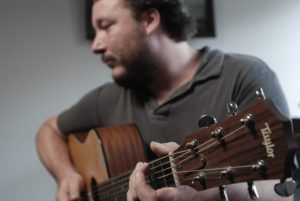written by Bill Meyer

Jack Rose was born on February 16, 1971. When he was 12 his grandma Nita bought him a guitar, and he put in hours of practice and took lessons to learn how to play it. Early on, Jack was drawn not only to the rock and roll he heard on the radio but the sounds of acoustic country blues. He determined to learn how to play them, but after a teacher assured him that he’d never get a gig playing that stuff he went electric. He played some bar band gigs when he was still a teenager, and then went to college in Richmond VA, where he fell in with punks and noise fans and started playing on that scene.
This new crew didn’t have much time for the blues, so Jack didn’t bring it up. There was plenty else to learn anyway, both from records and first-hand experience. Pelt, the band he joined in 1993, evolved beyond the entropic rock of their early records into autodidactic explorations of improvisation, drone, and Appalachian folk music. In those days he was a multi-instrumentalist, as likely to play harmonium or percussion as guitar. And while there are plenty of guitars on Via St. Louis, a collaboration with school chum Jason Bill that was the first record to bear Rose’s name, they’re mostly feeding back or reverberating after being smacked on the back. But as Pelt’s members delved further into old time music and their fans came around to folk mavericks like John Fahey, it became clear that there was a place for a more technically accomplished acoustic guitar voice.
In 2000 Jack played his first solo concert at a posthumous celebration of John Fahey’s birthday held at Brooke Sietinson’s house. Later that year the restaurant where he worked let him go after he declined to sugar up a cop’s coffee, and unemployment gave him a chance to woodshed. The following year he began playing fingerstyle guitar in public, both alone and with Pelt. By the time he recorded his first LP, Red Horse, White Mule, in 2001, he had already established an articulate and aggressive attack that expressed both the existential heaviness of old gospel blues and the improvisational exhilaration of extended fantasias cut from the same cloth as Fahey’s “Fare Forward Voyagers” and Robbie Basho’s “Lost Lagoon Suite.” The forward-thrusting blur of his extended pieces took in electronics and Indian percussion on Raag Manifestos and rustic duets with guitarists Mike Gangloff (of Pelt) and Glenn Jones on Opium Musick, but it all came together on the fourth LP, Kensington Blues, which was issued by VHF Records at the end of the summer of 2005. The tunes were more vivid, the improvising more fluid, the wonder more haunted; this was the point where Jack nailed his personal synthesis of the American guitar raga tradition.
On the half dozen records and endless tours that followed he dug further into old time, ragtime, the blues, and his own tunes, playing with ever more pith, and never losing a rhythmic heft distilled from classic rock. In 2009 he signed to Thrill Jockey Records, a label with the resources to push him up a few commercial notches. That fall he delivered a new LP called Luck In The Valley that added old-time and honky-tonk music to the ragtime, blues, gospel, and raga elements. It included contributions from Glenn Jones on banjo, pianist Hans Chew, Philadelphia friend Harmonica Dan, and his old Pelt mates in their old-time music guise as the Black Twig Pickers. Like Kensington Blues four years earlier, it was both an integration of what he had been doing and a platform for what would come next. Two months before its release, on December 5 2009, Jack died of a heart attack; the record release show that he had planned to take place in Philadelphia became a memorial to him, and a celebration of the legacy left by his music.